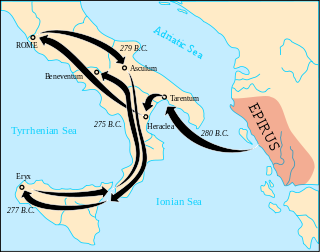
The 3rd century BC started the first day of 300 BC and ended the last day of 201 BC. It is considered part of the Classical Era, epoch, or historical period.
Year 241 BC was a year of the pre-Julian Roman calendar. At the time it was known as the Year of the Consulship of Atticus and Cerco. The denomination 241 BC for this year has been used since the early medieval period, when the Anno Domini calendar era became the prevalent method in Europe for naming years.

This article concerns the period 309 BC – 300 BC.
This article concerns the period 289 BC – 280 BC.
This article concerns the period 279 BC – 270 BC.
This article concerns the period 269 BC – 260 BC.
Year 251 BC was a year of the pre-Julian Roman calendar. At the time it was known as the Year of the Consulship of Metellus and Pacilus. The denomination 251 BC for this year has been used since the early medieval period, when the Anno Domini calendar era became the prevalent method in Europe for naming years.
Year 276 BC was a year of the pre-Julian Roman calendar. At the time it was known as the Year of the Consulship of Gurges and Clepsina. The denomination 276 BC for this year has been used since the early medieval period, when the Anno Domini calendar era became the prevalent method in Europe for naming years.
Year 275 BC was a year of the pre-Julian Roman calendar. At the time it was known as the Year of the Consulship of Dentatus and Caudinus. The denomination 275 BC for this year has been used since the early medieval period, when the Anno Domini calendar era became the prevalent method in Europe for naming years.
Year 278 BC was a year of the pre-Julian Roman calendar. At the time it was known as the Year of the Consulship of Luscinus and Papus. The denomination 278 BC for this year has been used since the early medieval period, when the Anno Domini calendar era became the prevalent method in Europe for naming years.

Year 279 BC was a year of the pre-Julian Roman calendar. At the time it was known as the Year of the Consulship of Publius Sulpicius Saverrio and Publius Decius Mus. The denomination 279 BC for this year has been used since the early medieval period, when the Anno Domini calendar era became the prevalent method in Europe for many years.
Year 281 BC was a year of the pre-Julian Roman calendar. At the time it was known as the Year of the Consulship of Barbula and Philippus. The denomination 281 BC for this year has been used since the early medieval period, when the Anno Domini calendar era became the prevalent method in Europe for naming years.

Pyrrhus was a Greek king and statesman of the Hellenistic period. He was king of the Molossians, of the royal Aeacid house, and later he became king of Epirus. He was one of the strongest opponents of early Rome, and had been regarded as one of the greatest generals of antiquity. Several of his victorious battles caused him unacceptably heavy losses, from which the phrase "Pyrrhic victory" was coined.

The Battle of Asculum was a poorly documented battle that took place near Asculum in 279 BC, and was thought to have lasted either one or two days, between the Roman Republic under the command of the consuls Publius Decius Mus and Publius Sulpicius Saverrio, and the forces of King Pyrrhus of Epirus. The battle took place during the Pyrrhic War, after the Battle of Heraclea of 280 BC, which was the first battle of the war. There currently exists accounts of this battle only by three ancient historians: Dionysius of Halicarnassus, Plutarch, and Cassius Dio, although these historians in turn reference other historians whose work is now lost. Asculum was in Lucanian territory, in southern Italy. The Battle of Asculum was the original "Pyrrhic victory". The result of the battle is not definitively known, with Plutarch stating that it was a pyrrhic Greek victory, Cassius Dio recording it as a Roman victory. The constituents of both armies are also poorly known, with each historian offering largely divergent estimates for the strength of the armies or the length of the battle.

The Pyrrhic War was largely fought between the Roman Republic and Pyrrhus, the king of Epirus, who had been asked by the people of the Greek city of Tarentum in southern Italy to help them in their war against the Romans.
Marcus Valerius Laevinus was a Roman consul and commander who rose to prominence during the Second Punic War and corresponding First Macedonian War. A member of the gens Valeria, an old patrician family believed to have migrated to Rome under the Sabine king T. Tatius, Laevinus played an integral role in the containment of the Macedonian threat.
The treaties between Rome and Carthage are the four treaties between the two states that were signed between 509 BC and 279 BC. The treaties influenced the course of history in the Mediterranean and are important for understanding the relationship between the two most important cities of the region during that era. They reveal changes in how Rome perceived itself and how Carthage perceived Rome, and the differences between the perception of the cities and their actual characteristics.

Epirus was an ancient Greek kingdom, and later republic, located in the geographical region of Epirus, in parts of north-western Greece and southern Albania. Home to the ancient Epirotes, the state was bordered by the Aetolian League to the south, Ancient Thessaly and Ancient Macedonia to the east, and Illyrian tribes to the north. The Greek king Pyrrhus is known to have made Epirus a powerful state in the Greek realm that was comparable to the likes of Ancient Macedonia and Ancient Rome. Pyrrhus' armies also attempted an assault against the state of Ancient Rome during their unsuccessful campaign in what is now modern-day Italy.
The Battle of the Cranita Hills was fought in 277 BC between a Roman and a Samnite army during the Pyrrhic War. The Samnite people allied with King Pyrrhus of Epirus against the Roman Republic to regain the independence that they had lost during the Roman Samnite wars, but when Pyrrhus left Italy in 278 BC for Sicily, Pyrrhus' Italian allies were left to defend against the Romans on their own.

The Battle of Eryx was one of the battles in the Pyrrhic War. It was held between the Kingdom of Epirus and the Magna Graecia of the Empire of Carthage, as part of the Sicilian Front in the Pyrrhic War. It ended in an Epirote victory.





